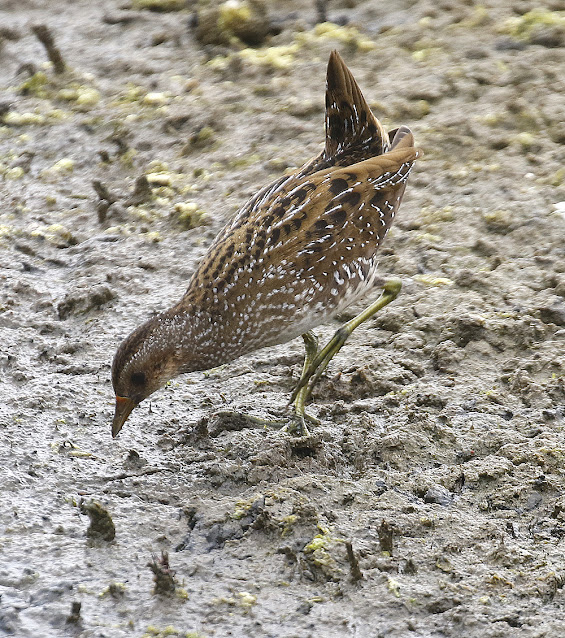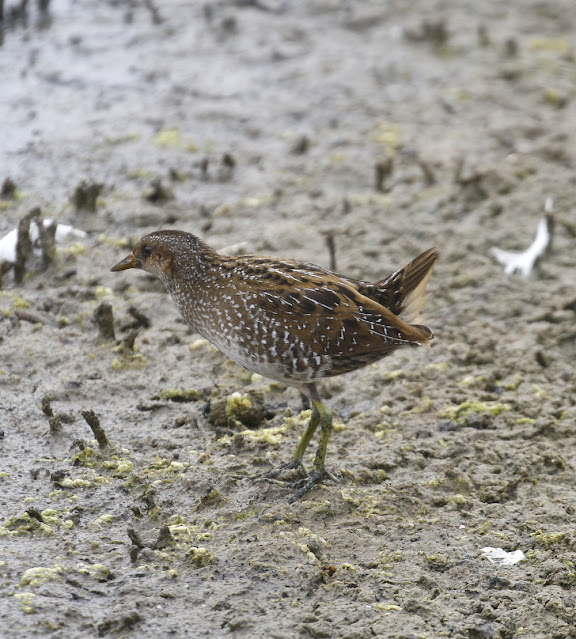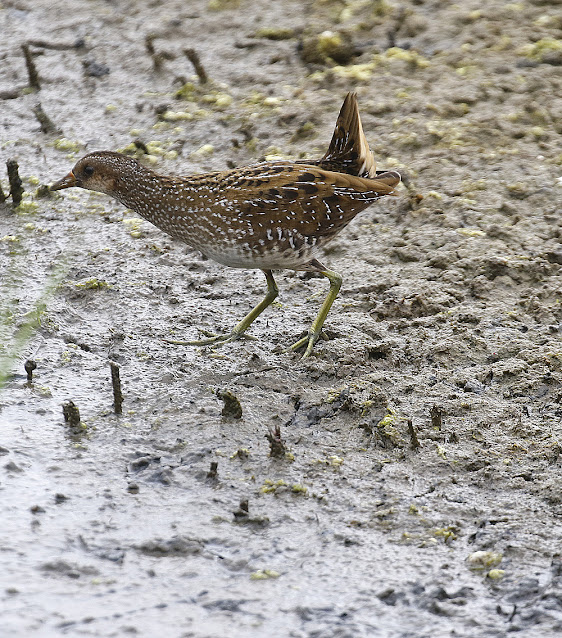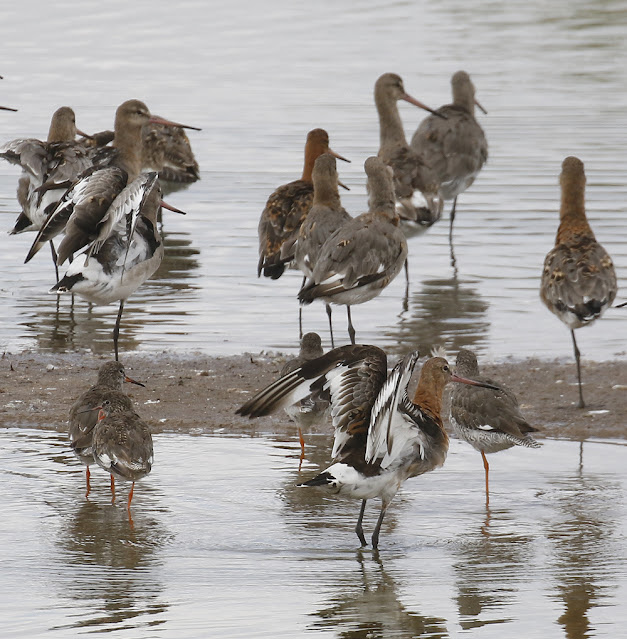Reports over the last few days of a juvenile Spotted Crake making itself uncharacteristically visible on a small patch of mud at Gibralter Point NNR in Lincolnshire definitely had me interested but not so sure when or if to make the three hour journey to go and try to see it.
Last week I was too tied up with various commitments to find the time or the weather was just not right. This weekend I figured this bird would be highly popular and I did not fancy being cooped up in a crowded hide with a scrum of birders and photographers. Not very pleasant and not my kind of birding.
Having ascertained that the crake was still there on Sunday and by all accounts was being very obliging, by Spotted Crake standards, I made plans to head for Gibralter Point on Monday. Gibralter Point is a National Nature Reserve administered by the Lincolnshire Wildlife Trust and covers 4.3 square kilometres and extends for 5 kilometres along the North Sea coast from the southern end of Skegness to the northern corner of The Wash.
I was aware that the crake was being seen from the Mere Hide at Gibralter Point but unsure of how much room there was in the hide, so I resolved to get there early in order to secure a seat and a good position in the hide.These days if you leave it too late you are likely to find the hide commandeered by photographers who can and often will sit in there all day, so it's best to arrive as early as possible.
I was aware that the crake was being seen from the Mere Hide at Gibralter Point but unsure of how much room there was in the hide, so I resolved to get there early in order to secure a seat and a good position in the hide.These days if you leave it too late you are likely to find the hide commandeered by photographers who can and often will sit in there all day, so it's best to arrive as early as possible.
I decided to arrive at 6am which meant a very early 3am start from my home in order to achieve this. It is a long and tedious journey to Gibralter Point which lies by the North Sea near the holiday town of Skegness, often the butt of jokes and irreverently known as Skeggy, Costa del Skeg or even Skegvegas. It is claimed to be one of the best places to retire to, judging on the infrastructure, hospitals and crime rates etc. and stated as 'being everything you could want in a tourist town' by Lonely Planet. Forgive me but I am not so sure. It is also the site of Butlin's first holiday camp. opened in 1936 and still going to this day. It cannot, however, escape the fact it is now a somewhat out of favour holiday destination, popular in former years maybe but before we all discovered warmer and more exotic foreign destinations.
I made good time on the virtually traffic free nightime roads, just occasional delivery vans and lorries joining me on the ring roads and dual carriageways as I circumvented the conurbations of Northampton and Peterborough. The dawn rose, uncertainly, as I entered the flat and featureless fenland of Lincolnshire, now no longer true fens, these having long since been drained and converted to huge expansive fields stretching away for dreary mile upon flat mile on both sides of the road.
The forecast was for a mild day with sunny periods but the looming clouds and light drizzle on the car's windscreen told another story. Two long lines of ragged, windblown Rooks sat hunched, shoulder to shoulder on telephone wires by the road, a picture of dejection.Their funereal appearance adding to the sense of gloom and abandonment that emanated from the forbidding landscape about me.
The forecast was for a mild day with sunny periods but the looming clouds and light drizzle on the car's windscreen told another story. Two long lines of ragged, windblown Rooks sat hunched, shoulder to shoulder on telephone wires by the road, a picture of dejection.Their funereal appearance adding to the sense of gloom and abandonment that emanated from the forbidding landscape about me.
Full on rain descended as I arrived on the outskirts of Boston. This added yet another layer of misery to my already downcast state of mind but the rain passed quickly into memory as I made my way out on the other side of Boston. The sky lightened and some white clouds began to appear in the heavens as I now entered an even greater emptiness of enormous rectangular fields stretching away, flat as a board for many a mile into a grey and murky distance. I followed the curving road, sinuous and snaking, seemingly forever, through the miles of flat fields, currently devoid of human life. The only feature to break the monotony were occasional distant huddles of trees, crowding close to each other, rounded in form like earthbound green cumulus clouds or single trees, marooned in a vast acreage of monotony. I carried on through tiny villages that were unremarkable in every respect, clinging to the lifeline of the road, which continued its curving route northeastwards, a grey snake writhing its way through this forgotten corner of England.
I arrived in Skegness and looping round the one way system took the road coastwards out to Gibralter Point, past the golf club. I was, as I hoped and planned, the first to arrive and parked the car in a currently completely empty Beach Car Park as instructed by RBA (Rare Bird Alert). Shortly afterwards a local birder arrived on a motorbike and joined me on the short walk to the Mere Hide.
He confirmed my concerns about the weekend, saying the small hide had been three deep with people wanting to see the crake. Once in the hide we set ourselves up in a corner with a good view of the area that the crake liked to frequent, a small apron of mud sandwiched between open water and a bank of sedge, in which it spent much of its time, occasionally coming out briefly into the open on the mud.
The light was truly appalling for photography, not a sign of the promised sun but a dull, sullen kind of a morning. I checked and altered my camera settings.
 |
| The Mere Hide |
 |
| The small muddy area surrounded by sedge and currently home to the Spotted Crake |
The view from the hide was restricted as the crake, when it came out was so close it was hard to see it over the top of a screen of sedge but there was nothing we could do about that. I sat with my new found colleague and we waited. Tired and a little fraught after my long drive and early start I wanted to sit quietly and pull myself together but my friend, a local birder, wanted to talk and in a very loud voice at that. He was pleasant enough but I feared his foghorn tones would scare the crake as it was so close to the hide, so I replied to him in a quiet whisper hoping he may get the hint but it did not work. Reed Warbler, he bellowed, as a small brown bird flew past the hide.
A small, furtive brown shape materialised at the edge of the sedge and briefly ventured out onto the mud. I looked hard, excited at first, but it was not the hoped for Spotted Crake but a juvenile Water Rail which, after venturing out into the open, completely lost its nerve and hurtled back into the cover of the sedge.
The Mere Hide is situated at one end of a reasonably sized lagoon of water, presumably 'The Mere' after which the Hide is named, surrounded by reeds and sedge and whilst waiting for the crake to show itself we were entertained by a succession of aquatic birds visiting the small muddy scrape. First to arrive were a family of Mute Swans, two adults leading their eight almost fully grown juveniles across the water. They did not stay for long and sailed off in a long line back up the lagoon.
Little Grebe parents were feeding their broods of young of various ages and came into the shallows chasing sticklebacks. Even the very small young birds had already mastered the art of chasing the fish, snorkelling with their heads under water as they swam on the surface while a fully grown bird sat on the water in front of us and demonstrated how it dealt with a stickleback.
Mallard, Teal and Tufted Ducks flew in to land on the deeper water and a Coot family had an inevitable dispute with a pair of Moorhens. Some twenty minutes, maybe more had passed, and then another small, brown and equally hesitant and furtive shape wandered out from the sedge onto the mud. Not very far but enough to see it was the Spotted Crake, smaller than a Water Rail with a very different profile of short stout bill and compact body, its pointed tail flicking up and down, flashing prominent buff undertail coverts in true crake fashion and evidence, if needed, of its nervous disposition. Silently, cameras at the ready, we willed it to move further out, clear from the annoying sedge but the crake wanted the exact opposite, to remain near to the re-assurance of the sedge and the sanctuary it provided and where it could flee at the slightest sense of danger.
Finally, gaining confidence, it came out enough to be photographed without the sedge getting in the way, feeding at the very edge of the water and picking up tiny seeds or something similar from the muddy margin. It waded out into the water slightly but seconds later it bolted for cover, rounded wings flapping to assist its progress as its long green legs and toes propelled it back into cover. The cause of its alarm became apparent as a young Water Rail emerged from the sedge.
So here was my first, brief but nonetheless satisfactory, view of the Spotted Crake and now we sat and awaited a repeat emergence of the crake from its sedgy hiding place. Being a Monday and early, there were few other visitors to the hide, but the warden came in and chatted briefly, telling us that people had to wait three hours yesterday before it showed itself and on other days it had disappeared completely in the afternoons.We felt all the better for this, having already seen it after just a thirty minute wait.
The warden left and the crake once more emerged and this time remained out in the open for a few minutes before seeking cover once more. Later, in its absence, a Common Snipe landed on the mud and the crake shot out of the sedge and chased it off, something I would never have suspected it of doing, the snipe being larger than the crake.
After this the crake disappeared around a corner of the sedge and we saw nothing more of it for at least forty five minutes. The Common Snipe returned and this time remained un-molested by the crake and fed in the shallows and then indulged in a spot of preening.They are such remarkable looking birds with that outlandishly long bill and big dark eye placed far back on their head, and their pale green legs appear not quite long enough to make its overall form look balanced. The cryptic plumage of straw yellow, buff and dark brown are the colours of the dead reeds and sedge they love to secrete themselves in.
Meanwhile other birders, not many, came and went, not willing to wait for any length of time for the crake to appear.
A couple who had stuck it out finally gave up and left. Of course five minutes later the crake re-emerged and this time put on quite a performance, standing and feeding in the open for at least five minutes which by Spotted Crake standards is a lifetime. Our cameras clicked away in staccato volleys recording the moment and then, remarkably the crake was joined by another or the same juvenile Water Rail as before. Each warily eyed the other as they stood inches apart, almost as if they could not believe the situation they found themselves in, before the Water Rail returned to the sedge to be followed shortly afterwards by the Spotted Crake.
There was one more brief appearance of the crake before it flew with long dangling legs across a small channel of water and into some deep sedge. It was gone and I decided this was the time to bid it farewell.
I left the hide and went back to the car park and had a look at the scrapes from the hides on the other side of the approach road. There was a huge gathering of Black tailed Godwits on the scrapes along with some Avocets and Common Redshanks. A scene of constant activity as many of the birds were vigorously preening, no doubt feeling a constant irritation of moulting feathers. I noticed the godwits regularly dipped the tip of their long bills in the water to moisten them before returning to preening those annoying feathers.
The godwits are now rapidly acquiring their grey winter plumage, some already fully transformed, others partially so and a small number still in their summer plumage of orange and black.
 |
| Juvenile Water Rail |
 |
| Juvenile Mute Swans |
 |
 |
| Little Grebes of varying ages |
Finally, gaining confidence, it came out enough to be photographed without the sedge getting in the way, feeding at the very edge of the water and picking up tiny seeds or something similar from the muddy margin. It waded out into the water slightly but seconds later it bolted for cover, rounded wings flapping to assist its progress as its long green legs and toes propelled it back into cover. The cause of its alarm became apparent as a young Water Rail emerged from the sedge.
So here was my first, brief but nonetheless satisfactory, view of the Spotted Crake and now we sat and awaited a repeat emergence of the crake from its sedgy hiding place. Being a Monday and early, there were few other visitors to the hide, but the warden came in and chatted briefly, telling us that people had to wait three hours yesterday before it showed itself and on other days it had disappeared completely in the afternoons.We felt all the better for this, having already seen it after just a thirty minute wait.
The warden left and the crake once more emerged and this time remained out in the open for a few minutes before seeking cover once more. Later, in its absence, a Common Snipe landed on the mud and the crake shot out of the sedge and chased it off, something I would never have suspected it of doing, the snipe being larger than the crake.
After this the crake disappeared around a corner of the sedge and we saw nothing more of it for at least forty five minutes. The Common Snipe returned and this time remained un-molested by the crake and fed in the shallows and then indulged in a spot of preening.They are such remarkable looking birds with that outlandishly long bill and big dark eye placed far back on their head, and their pale green legs appear not quite long enough to make its overall form look balanced. The cryptic plumage of straw yellow, buff and dark brown are the colours of the dead reeds and sedge they love to secrete themselves in.
Meanwhile other birders, not many, came and went, not willing to wait for any length of time for the crake to appear.
A couple who had stuck it out finally gave up and left. Of course five minutes later the crake re-emerged and this time put on quite a performance, standing and feeding in the open for at least five minutes which by Spotted Crake standards is a lifetime. Our cameras clicked away in staccato volleys recording the moment and then, remarkably the crake was joined by another or the same juvenile Water Rail as before. Each warily eyed the other as they stood inches apart, almost as if they could not believe the situation they found themselves in, before the Water Rail returned to the sedge to be followed shortly afterwards by the Spotted Crake.
There was one more brief appearance of the crake before it flew with long dangling legs across a small channel of water and into some deep sedge. It was gone and I decided this was the time to bid it farewell.
I left the hide and went back to the car park and had a look at the scrapes from the hides on the other side of the approach road. There was a huge gathering of Black tailed Godwits on the scrapes along with some Avocets and Common Redshanks. A scene of constant activity as many of the birds were vigorously preening, no doubt feeling a constant irritation of moulting feathers. I noticed the godwits regularly dipped the tip of their long bills in the water to moisten them before returning to preening those annoying feathers.
 |
| Black tailed Godwits, Common Redshanks and an Avocet |



































No comments:
Post a Comment